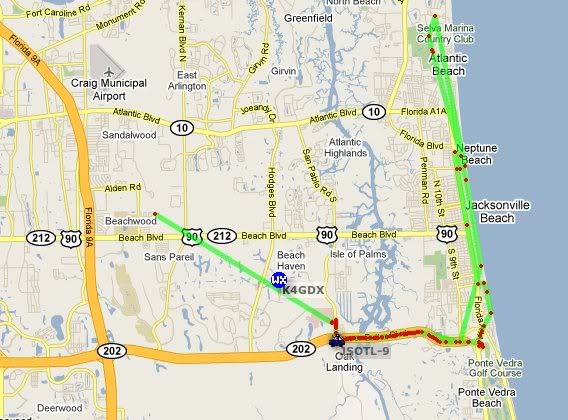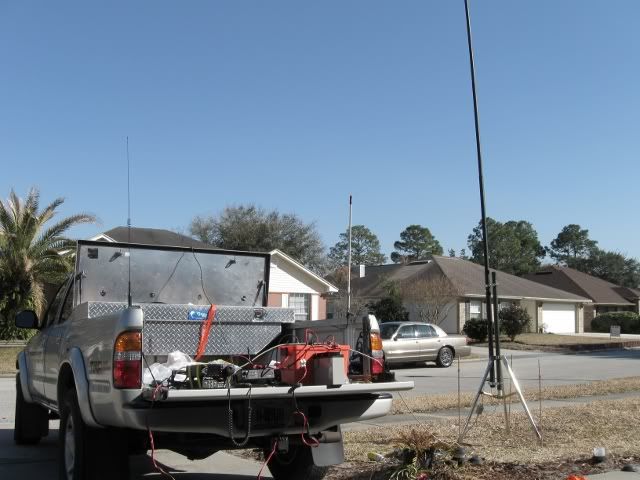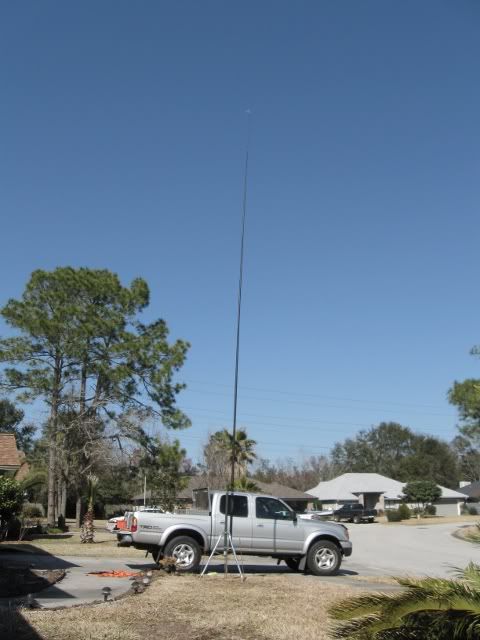One of the issues I've been battling since making the switch to Linux is getting my radio programming software to work. The apps run under Wine but I couldn't get my USB/serial adapter to be recognized by the software.
I finally had success tonight. It was so simple I'm kicking myself. All I needed to do was create a symbolic link from the device to the COM port I wanted it assigned to. So the syntax is:
ln -s /dev/ttyUSB0 ~/.wine/dosdevices/comx
where 'x' is the port number. Works like a dream!
Thursday, February 25, 2010
Wednesday, February 24, 2010
New Position
Well, it's with mixed emotions but I was appointed as the ARES Emergency Coordinator at tonight's meeting. Our District EC made the announcement and it was approved later in the evening when our Section Manager arrived. I truly wish my predecessor hadn't needed to step down but I'll do my best.
We had a great meeting. Our guest speaker had to be pleased with the more than 50 people in attendance. He gave a great 2-hr talk on D-Star and his vision for the East Coast of Florida. Hopefully we'll be another D-Star hub in the state in the next few weeks. Looking forward to learning and exploring some new technology.
We had a great meeting. Our guest speaker had to be pleased with the more than 50 people in attendance. He gave a great 2-hr talk on D-Star and his vision for the East Coast of Florida. Hopefully we'll be another D-Star hub in the state in the next few weeks. Looking forward to learning and exploring some new technology.
Sunday, February 21, 2010
Marathon APRS Success...Mostly
It was an early start to the day. The alarm went off at 5:20 and my fellow net control operator arrived in time for us to leave by 6. We picked up our NCS student at 6:08 and then got stuck in traffic. It's usually not a problem but road construction and fewer lanes killed us. We arrived later than expected but didn't have to rush too terribly much to get on the air for a 7am roll call.
About 7:30 the JSO tail car arrived and I installed the radio with the GPS and APRS TinyTrak. The officer driving was very happy to help us and we certainly appreciate it. I monitored via the Blackberry and through my new Virgin Mobile pre-paid wireless broadband account. As the race started fear set it as I realized I'd stopped getting updates. Fortunately I had the mindset to stop the tail car before he went through the finish line. It's a good thing I did. Somehow the power had become disconnected and the TinyTrak was off.
With that catastrophe averted I jogged back to the side to head back to the command post when I heard APRS bursts on the net frequency. That's when more panic set it. The side of the 8800 I had the APRS on is normally set to the repeater we used for the net. Off I went running after the JSO patrol car to stop him again. I was pleased that it wasn't me. :-)
All in all the device worked well. Unfortunately I did have very large gaps in coverage. It was configured to transmit every 60 seconds. Sometimes it wouldn't update for 60 minutes. Just when I'd give up I'd get a good update. I need to go through the raw data but I don't know if it'll tell me much. I did hear that a couple of other operators also had gaps in their APRS updates so maybe it was just the area and not me. We weren't too far from the nearest digipeater so I wouldn't have expected spotty coverage but you never know.
If nothing else I at least have some other ideas now for planning the APRS usage for the Tour de Cure in May. Namely I think we'll need to provide our own digipeater AND igate. Time to do some more research.
Had a great time and after the initial chill of the morning we had a beautiful day. For the record, Mr. Buddy is a great little heater. ;-)

About 7:30 the JSO tail car arrived and I installed the radio with the GPS and APRS TinyTrak. The officer driving was very happy to help us and we certainly appreciate it. I monitored via the Blackberry and through my new Virgin Mobile pre-paid wireless broadband account. As the race started fear set it as I realized I'd stopped getting updates. Fortunately I had the mindset to stop the tail car before he went through the finish line. It's a good thing I did. Somehow the power had become disconnected and the TinyTrak was off.
With that catastrophe averted I jogged back to the side to head back to the command post when I heard APRS bursts on the net frequency. That's when more panic set it. The side of the 8800 I had the APRS on is normally set to the repeater we used for the net. Off I went running after the JSO patrol car to stop him again. I was pleased that it wasn't me. :-)
All in all the device worked well. Unfortunately I did have very large gaps in coverage. It was configured to transmit every 60 seconds. Sometimes it wouldn't update for 60 minutes. Just when I'd give up I'd get a good update. I need to go through the raw data but I don't know if it'll tell me much. I did hear that a couple of other operators also had gaps in their APRS updates so maybe it was just the area and not me. We weren't too far from the nearest digipeater so I wouldn't have expected spotty coverage but you never know.
If nothing else I at least have some other ideas now for planning the APRS usage for the Tour de Cure in May. Namely I think we'll need to provide our own digipeater AND igate. Time to do some more research.
Had a great time and after the initial chill of the morning we had a beautiful day. For the record, Mr. Buddy is a great little heater. ;-)

Saturday, February 20, 2010
Marathon Preps and APRS
Tomorrow is the 3rd annual 26.2 with Donna Breast Cancer Marathon. Our ARES group has supported it since it began and it's really an enjoyable event for us. It also kicks off our busy season as things really roll into high gear after March 1.
This year we wanted to try a couple of new things. First is the Depiction software. I'd really hoped to use it to have a consolidated view of the event. I had the full course loaded on the street map when I hit a snag. I hadn't considered the possibility of activation problems and for whatever reason I have been unable to get it activated on my laptop. Since I waited until today to try there wasn't any chance of getting tech support to help me manually activate it. I guess we'll chalk this up as a lesson learned.
The second area we wanted to explore was APRS. Typically when we want to find where the end of the race is we have to call around trying to find the tail car and it's not always a timely affair. This year I decided to install an APRS tracker in the tail car. Much to my delight the Sheriff's Office was happy to let us do so.
Unfortunately, now that we had permission up the chain of command, things went south in a hurry. Not only had my TinyTrak stopped working with the Motorola Radius, now it isn't even working with my FT-8800. I'm not sure what was going on. I'd tried so many changes of the configuration, output levels, etc. that I gave up.
Well, a miracle happened and I finally got it working. I still don't know what the problem was (which I hate) but I was able to drive around town a bit and had patchy coverage. It wasn't perfect but hopefully it'll be good for tomorrow.
Since I was having so much trouble with the APRS stuff I decided to give my mind a break before I went postal. At the Orlando Hamcation last weekend I picked up a new vertical antenna for emergency deployment. It's the Eagle One Vertical Antenna. I set it up the first time in about 10 minutes (had some hardware to deal with) and was pleased at least with its receive capabilities. It seemed to be picking up a lot of stations across the bands very clearly. Unfortunately I did want to get back to the APRS issue since it was fairly critical so I didn't have it on the air long but I did get a good signal report from a NC station.
I chalked it up as a success. Can't wait to put it on the air again soon.



This year we wanted to try a couple of new things. First is the Depiction software. I'd really hoped to use it to have a consolidated view of the event. I had the full course loaded on the street map when I hit a snag. I hadn't considered the possibility of activation problems and for whatever reason I have been unable to get it activated on my laptop. Since I waited until today to try there wasn't any chance of getting tech support to help me manually activate it. I guess we'll chalk this up as a lesson learned.
The second area we wanted to explore was APRS. Typically when we want to find where the end of the race is we have to call around trying to find the tail car and it's not always a timely affair. This year I decided to install an APRS tracker in the tail car. Much to my delight the Sheriff's Office was happy to let us do so.
Unfortunately, now that we had permission up the chain of command, things went south in a hurry. Not only had my TinyTrak stopped working with the Motorola Radius, now it isn't even working with my FT-8800. I'm not sure what was going on. I'd tried so many changes of the configuration, output levels, etc. that I gave up.
Well, a miracle happened and I finally got it working. I still don't know what the problem was (which I hate) but I was able to drive around town a bit and had patchy coverage. It wasn't perfect but hopefully it'll be good for tomorrow.
Since I was having so much trouble with the APRS stuff I decided to give my mind a break before I went postal. At the Orlando Hamcation last weekend I picked up a new vertical antenna for emergency deployment. It's the Eagle One Vertical Antenna. I set it up the first time in about 10 minutes (had some hardware to deal with) and was pleased at least with its receive capabilities. It seemed to be picking up a lot of stations across the bands very clearly. Unfortunately I did want to get back to the APRS issue since it was fairly critical so I didn't have it on the air long but I did get a good signal report from a NC station.
I chalked it up as a success. Can't wait to put it on the air again soon.



Tuesday, February 2, 2010
Depiction
A couple of us have been talking about depiction and how we might use it in our ARES group as well as some of the special events our local radio club participates in. If you're not familiar with depiction it allows you to bring together various data sources into a single, integrated environment. You can also share your information with other users so that everybody stays on the same page.
Depiction is a .NET application and, of course, I'm running Linux. My mission at the moment is to get the software running under Linux without having to resort to installing inside a virtual machine. Sure, I have several VMs running with various Windows versions but if I can get something running outside the VM I will. And so I've embarked on the journey...
I ran into my first stumbling block with the .NET 3.5 Framework. I didn't really expect much and got just that. .NET only appears to have worked successfully on Linux using tools like winetricks up to version 2.0. I have yet to find any good stories with later versions. I decided to give DotGNU a try and that's where I am at the moment.
So far I've successfully made and installed the following modules: treecc, pnet and pnetlib. I even have proof that it worked:
x:/DotGNU/pnet-0.8.0/samples$ ../engine/ilrun hello.exe
Hello World!
Depiction is a .NET application and, of course, I'm running Linux. My mission at the moment is to get the software running under Linux without having to resort to installing inside a virtual machine. Sure, I have several VMs running with various Windows versions but if I can get something running outside the VM I will. And so I've embarked on the journey...
I ran into my first stumbling block with the .NET 3.5 Framework. I didn't really expect much and got just that. .NET only appears to have worked successfully on Linux using tools like winetricks up to version 2.0. I have yet to find any good stories with later versions. I decided to give DotGNU a try and that's where I am at the moment.
So far I've successfully made and installed the following modules: treecc, pnet and pnetlib. I even have proof that it worked:
x:/DotGNU/pnet-0.8.0/samples$ ../engine/ilrun hello.exe
Hello World!
Subscribe to:
Posts (Atom)


